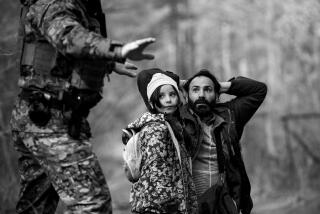Young and desperate
It was the anguish of a 9-year-old child that made Rebecca Cammisa vow to press on.
When the filmmaker first met the Honduran boy named Jose at a detention center in southern Mexico, he was alone, scared and crying. He was one of an estimated tens of thousands of Latin American children who annually try to cross illegally into the United States, many by riding the tops of railroad freight cars, most in search of work or missing parents.
For many, the journey ends badly, if not tragically. Menaced by predatory smugglers and corrupt police, the children (the majority from Mexico and Central America) must contend with dodgy weather, hunger and the constant danger of falling off the trains and being killed or losing limbs.
Some travel hundreds of miles only to be intercepted by law enforcement agents and deported home. When Cammisa filmed Jose, he was an underage refugee adrift in an international legal limbo.
“This film took a long time to make, and I kept going back to that scene,” says Cammisa, speaking by phone about her harrowing new documentary, “Which Way Home,” which was screened this summer at the Los Angeles Film Festival and will premiere Monday on HBO. “I just felt this film had to be made at any cost.”
The flood of illegal immigration into the United States from Latin America in recent years is a familiar if still highly contentious story. It’s been dramatized and investigated in numerous documentaries such as “Los que se quedan” (Those Who Remain); feature films including Gregory Nava’s “El Norte” (1984) and the more recent “La Misma Luna” (Under the Same Moon) and “Sin Nombre”; plays, such as Angel Norzagaray’s “Cartas al pie de un arbol” (Letters at the Foot of a Tree); and in art and photography exhibitions.
Without resorting to any background narration, “Which Way Home” raises questions about cross-border immigration policies and the macro-economic causes that propel people from struggling countries to stream into developed ones.
But for many viewers, the most direct impact of “Which Way Home” will be registered in the simple, poignant stories it tells of vulnerable, often dangerously naive young people pursuing a vague idea of bettering their lives by cutting themselves off from their families and communities. Filmed in El Salvador, Mexico, Honduras, Guatemala and the United States, the movie depicts a number of these innocents abroad, including the Honduran best friends Kevin and Fito, who are tracked en route to southern Texas. The ultimate fate of some children who appear in the film is unknown.
“What’s so powerful about the film is it really reminds you of what a great country we live in, and that people are desperate to come here,” says Sara Bernstein, HBO’s vice president of documentary programming and supervising producer of “Which Way Home.”
Cammisa said she first came upon the subject of child migrants in the fall of 2002, when she got a call from a Los Angeles friend who’d seen “Enrique’s Journey,” Sonia Nazario’s Pulitzer Prize-winning Los Angeles Times series about a young Honduran boy who went in search of his mother after she’d gone to work in North Carolina.
“I read all six chapters and I was completely taken by the story,” Cammisa says of The Times’ series. “Wow, I thought, this would really make a very powerful film.”
It would take six and a half years to complete her work. Much of the delay was due to the difficulty of getting funding, even though Cammisa was awarded a 2006 Fulbright grant and received some financial support from HBO and also from the Sundance Documentary Fund. “To talk about immigration back in 2003, 2004, it’s not the sexiest issue,” she says. “At the time I found the discussion in the media, especially on television, extremely negative, and not that much in depth.”
Among the people who lent a sympathetic ear were Lianne Halfon and Russ Smith, partners of actor John Malkovich in the L.A.-based production company Mr. Mudd, which has helped bring to the screen such feature films as the Malkovich-directed “The Dancer Upstairs” and the Oscar-winning “Juno.” Halfon says that she and her partners were so moved by Cammisa’s eight-minute trailer, including the footage of Jose, that they decided to executive produce the project.
“The story was sort of a revelation, and the emotions it elicited were so powerful,” Halfon says.
“We’re all parents,” Smith adds, “and I think it’s a pretty hard thing to see.”
Before filming began, Cammisa obtained permission from the children’s parents. She and her crew also made a pact to place the children’s welfare above their own interests in recording dramatic material.
Among the film’s other challenges was the difficulty in obtaining insurance to cover the dangerous train travel, and Cammisa’s limited Spanish. (Her mostly Mexican film crew helped bridge the communication gap.)
To capture the children’s most intimate, natural moments, Cammisa adopted the same patient, fly-on-the-wall approach that she used to film her 2002 documentary “Sister Helen,” about a widow who opened a South Bronx home for recovering addicts.
Cammisa hopes that “Which Way Home” may help to inform some Latin American parents about the dangers awaiting their children if they travel the road leading north. She has partnered with UNICEF on an outreach campaign and hopes to show the film in a number of small villages as a kind of cautionary tale. She also is in the process of creating a mechanism that will help the movie’s viewers donate to shelters that aid child migrants.
And although Cammisa doesn’t think that “Americans should have a blanket response” to the complex issues the film addresses, she emphasizes that “this isn’t some terrible thing happening in some corner of the world. This is happening in our backyard.”
--
More to Read
Only good movies
Get the Indie Focus newsletter, Mark Olsen's weekly guide to the world of cinema.
You may occasionally receive promotional content from the Los Angeles Times.











